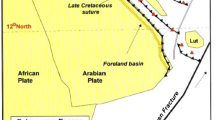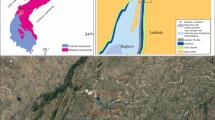Abstract
The chondrite-normalized REE distribution patterns in recent sediments from the northern South China Sea and surrounding areas are similar, with the HREE values being almost equal to or slightly higher, and the LaN/LuN ratio being lower, than PAAS standards. However, samples from the Xijiang River, a major branch of the Pearl River system, show opposite trends, i.e., with slightly lower HREE values and higher LaN/LuN ratio than PAAS. The distribution of Nd isotopes in sediments from the northern South China Sea was controlled by the Pearl River and the inshore area of South China, respectively. The volume of εNd(0) from inshore areas of southern China is apparently higher than that from the Pearl River, and εNd(0) values in offshore sediments and Taiwan Island are between these values. The results clearly show that εNd(0) volume in the northeastern South China Sea is higher than in the southwest part of the northern South China Sea, indicating different source rock types. The main source rock of the Pearl River sediment is carbonate types and affects sediment deposition in the southwest of the northern South China Sea, while the source rock in the inshore area of southern China, mainly Mesozoic and Cenozoic granites, contributes to sediments in the northeastern area of the northern South China Sea. Due to different source rock types, the HREE values and the volume of εNd(0) in recent sediments supplied by the inshore area of southern China are higher than those from the Pearl River. Over 80% of the rapidly accumulated sediments on the northern slope of the South China Sea in the southeast of Dongsha Islands area were derived from Taiwan Island and from inshore areas of South China, with only less than 20% from the Pearl River.
Similar content being viewed by others
References
Sarnthein M, Pflaumann U, Wang P X, et al., eds. Preliminary report on Sonne-95 cruise “Monitor Monsoon” to the South China Sea. Reports, Geol Palaont Inst Uni Kiel, 68. 1994. 1-125
Wang L J, Sarnthein M. High-resolution paleoceanographic records during the last 40000 years from the northern slope of the South China Sea (in Chinese with English abstract). Quat Sci, 1999, 19(1): 27–31
Wang P X, Prell W L, Blum P, et al., eds. Proceedings of the Ocean Drilling Program, Initial Reports South China Sea. Volume 184, College Station TX (Ocean Drilling Program), 2000, 18–20
Clift P, Lee J I, Clark M, et al. Erosional response of South China to arc rifting and monsoonal strengthening: a record from the South China Sea. Mar Geol, 2002, 184: 207–226
Luedmann T, Wong H K, Wang P X. Plio-Quaternary sedimentation processes and neotectonics of the northern continental margin of the South China Sea. Mar Geol, 2001, 172: 331–358
Pang X, Chen C M, Wu M S, et al. The Pearl River deep-water fan systems and significant geological events (in Chinese with English abstract). Adv Earth Sci, 2006, 21(8): 7–14
Shao L, Pang X, Qiao P J, et al. Sedimentary filling of the Pearl River Mouth Basin and its response to the evolution of the Pearl River (in Chinese with English abstract). Acta Sediment Sin, 2008, 26(2): 179–185
Shao L, Li X H, Wei G J, et al. Provenance of a prominent sediment drift on the northern slope of the South China Sea. Sci China Ser D-Earth Sci, 2001, 44(10): 919–925
Sun X J, Li X, Berg H J. Pollen distribution in hemipelagic surface sediments of the South China Sea and its relation to modern vegetation distribution. Mar Geol, 1999, 156: 211–226
Wang L J, Sarnthein M, Erlenkeuser H, et al. East Asian monsoon climate during the late Pleistocene: High-resolution sediment records from the South China Sea. Mar Geol, 1999, 156: 245–284
Shao L, Li X J, Gen J H, et al. Deep water bottom current deposition in the northern South China Sea. Sci China Ser D-Earth Sci, 2007, 50(7): 1060–1066
Li X H, Wei G J, Shao L, et al. Geochemical and Nd isotopic variations in sediments of the South China Sea: A response to Cenozoic tectonic in SE Asia. Earth Planet Sci Lett, 2003, 211: 207–220
Huang C Y. Taiwan Tectonics (in Chinese). Taibei: Geological Society China, 2002. 1–207
Taylor S R, McLennan S M, eds. The Continental Crust: its composition and evolution. An Examination of the Geochemical Record Preserved in Sedimentary Rocks. Oxford: Blackwell Scientific Publication, 1985. 1–301
McLennan S M. Rare earth elements in sedimentary rocks: influence of provenance and sedimentary processes. In: Lipin B R, et al. eds. Geochemistry and Mineralogy of Rare Earth Elements. Mineral Soc Am, Washington, 1989, 169–200
McLennan S M, Hemming S, McDaniel M J, et al. Geochemical approaches to sedimentation, provenance and tectonics. In: Jonhanson M J, et al. eds. Processes controlling the composition of clastic sediments, Boulder, Colorado. Geol Soc Am Spec Paper 284, 1993. 21–40
Rollinson H R, ed. Using Geochemical Data: Evaluation, Presentation, Interpretation. Singapore: Longman Scientific & Technical, 1993. 1–352
Mou B. Elements Geochemistry (in Chinese). Beijing: Peking University Press, 1999. 27–169
Chen J, Wang H. Geochemistry (in Chinese). Beijing: Science Press, 2004. 410
Nesbitt H W, Markovice G, Price R. Chemical processes affecting alkalis and alkaline earths during continental weathering. Geochim Cosmochim Acta, 1980, 44: 1659–1666
Nesbitt H W, Markovice G. Weathering of granodioritic crust, long-term storage of elements in weathering profiles, and petrogenesis of siliciclastic sediments. Geochim Cosmochim Acta, 1997, 61: 1653–1670
Nelson B K, DePaolo D J. Application of Sm-Nd and Rb-Sr isotopic systematics to studies of provenance and basin analysis. J Sediment Petrol, 1988, 58: 348–357
Wang P X, et al. The South China Sea Since Last 150000 Years (in Chinese). Shanghai: Tongji University Press, 1995. 10–14
Milliman J D, Meade R H. World-wide delivery of river sediment to the ocean. J Geol, 1983, 91: 1–21
Luedmann T, Wong H K, Berglar K. Upward flow of North Pacific Deep Water in the northern South China Sea as deduced from the occurrence of drift sediments. Geophys Res Lett, 2005, 32: L05614
Liu Z, Zhao H, Fan S, et al. Geology of the South China Sea (in Chinese). Beijing: Science Press, 2002. 1–13
Author information
Authors and Affiliations
Corresponding author
Additional information
Supported by National Natural Science Foundation of China (Grant Nos. 40276019, 40238060 and 40621063), and National Basic Research Program of China (Grant No. 2007CB819501)
About this article
Cite this article
Shao, L., Qiao, P., Pang, X. et al. Nd isotopic variations and its implications in the recent sediments from the northern South China Sea. Chin. Sci. Bull. 54, 311–317 (2009). https://doi.org/10.1007/s11434-008-0453-8
Received:
Accepted:
Published:
Issue Date:
DOI: https://doi.org/10.1007/s11434-008-0453-8




